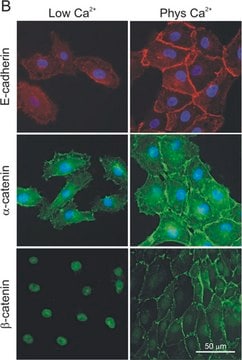MABS1327
Anti-Podocalyxin (GP135) Antibody, clone 3F2:D8
clone 3F2:D8, from mouse
Sinónimos:
Podocalyxin-like protein 1, GP1345, PC, PC-like protein 1, PCLP-1, cPCLP1
About This Item
Productos recomendados
biological source
mouse
Quality Level
antibody form
purified immunoglobulin
antibody product type
primary antibodies
clone
3F2:D8, monoclonal
species reactivity
canine
packaging
antibody small pack of 25 μL
technique(s)
immunocytochemistry: suitable
immunofluorescence: suitable
immunoprecipitation (IP): suitable
radioimmunoassay: suitable
western blot: suitable
isotype
IgG1κ
NCBI accession no.
UniProt accession no.
shipped in
ambient
target post-translational modification
unmodified
Gene Information
human ... PODXL(5420)
General description
Specificity
Immunogen
Application
Signaling
Radioimmunoassay Analysis: A representative lot detected Podocalyxin (GP135) in Radioimmunoassay applications (Ojakian, G.K., et. al. (1988). J Cell Biol. 107(6 Pt 1):2377-87).
Immunofluorescence Analysis: A representative lot detected Podocalyxin (GP135) in Immunofluorescence applications (Ojakian, G.K., et. al. (1988). J Cell Biol. 107(6 Pt 1):2377-87; Cheng, H.Y., et. al. (2005). J Am Soc Nephrol. 16(6):1612-22).
Immunocytochemistry Analysis: A 1:100 dilution from a representative lot detected Podocalyxin (GP135) in MDCK cells (Courtesy of Dr. Tzuu-Shuh Jou, M.D., Ph.D., Graduate Institute of Clinical Medicine, College of Medicine, National Taiwan University).
Immunocytochemistry Analysis: A representative lot detected Podocalyxin (GP135) in Immunocytochemistry applications (Ojakian, G.K., et. al. (1988). J Cell Biol. 107(6 Pt 1):2377-87; Cheng, H.Y., et. al. (2005). J Am Soc Nephrol. 16(6):1612-22).
Western Blotting Analysis: A representative lot detected Podocalyxin (GP135) in Western Blotting applications (Ojakian, G.K., et. al. (1988). J Cell Biol. 107(6 Pt 1):2377-87; Cheng, H.Y., et. al. (2005). J Am Soc Nephrol. 16(6):1612-22).
Immunoprecipitation Analysis: A representative lot detected Podocalyxin (GP135) in Immunoprecipitation applications (Ojakian, G.K., et. al. (1988). J Cell Biol. 107(6 Pt 1):2377-87; Cheng, H.Y., et. al. (2005). J Am Soc Nephrol. 16(6):1612-22).
Quality
Western Blotting Analysis: A 1:1,000 dilution of this antibody detected Podocalyxin (GP135) in MDCK cell lysate.
Target description
Physical form
Storage and Stability
Other Notes
Disclaimer
Not finding the right product?
Try our Herramienta de selección de productos.
Storage Class
12 - Non Combustible Liquids
wgk_germany
WGK 1
Certificados de análisis (COA)
Busque Certificados de análisis (COA) introduciendo el número de lote del producto. Los números de lote se encuentran en la etiqueta del producto después de las palabras «Lot» o «Batch»
¿Ya tiene este producto?
Encuentre la documentación para los productos que ha comprado recientemente en la Biblioteca de documentos.
Nuestro equipo de científicos tiene experiencia en todas las áreas de investigación: Ciencias de la vida, Ciencia de los materiales, Síntesis química, Cromatografía, Analítica y muchas otras.
Póngase en contacto con el Servicio técnico







